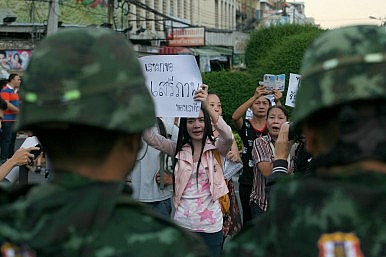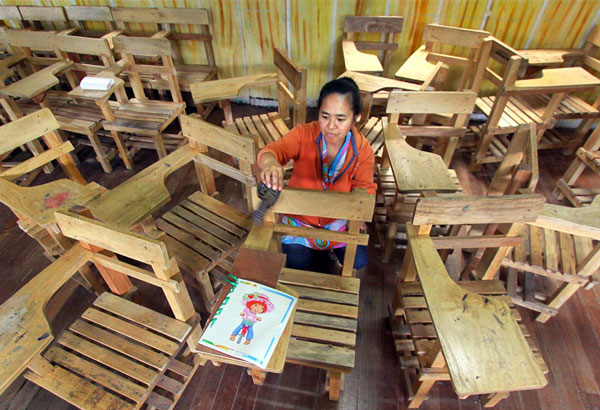Reashot Xigwin
SENIOR MEMBER

- Joined
- Oct 20, 2012
- Messages
- 5,747
- Reaction score
- 0
Whither Asean identity and consciousness?
By Johan Jaaffar | Twitter: @Johan_Jaaffar | [email protected]

CHALLENGES AHEAD: Despite Asean being the melting pot of cultures and diversity, it still lacks the mindset, identity and oneness for a people-centred regional community
NEXT year Malaysia will take over the chairmanship of Asean. The detractors are saying Asean is already 47 years old and exhibiting serious symptoms of mid-aged crisis. It has lost its lustre and a sense of purpose. In fact, there are those who questioned the relevance of the association. Many would like to believe that Asean is steeped in rhetoric but little on substance.
The truth is for almost five decades Asean has played an important role in ensuring security, socio-cultural dynamics and economic wellbeing of its member states. Asean covers a land area of more than 4.4 million kilometres, a population of 620 million and a combined gross domestic product of at least RM7.8 trillion. It is a force to be reckoned with. It is as diverse as any regional organisation, perhaps even more so. At least 150 major and minor languages and dialects are spoken here. Asean is indeed the melting pot of cultures and diversity.
Asean is also a study in anachronism. It has a first world nation and some of the poorest third world countries. It consists of sprawling metropolises as well as far-flung hammocks hundreds of kilometres away from the nearest town. There are areas that are fully wired and yet there are pockets where even a dial tone has never been heard of.
Asean is about Richistan (the land of the rich) and hundreds of millions of others living on less than RM5 a day. Asean is all that and more.
What seem to be the unifying factors for Asean? Some would argue there is a dire need for an Asean consciousness, whatever that means. Or perhaps an Asean mindset, which is almost utopian in execution. Or the need to create an Asean community which is the goal adopted by the member nations.
The road map for the Asean community is already in place, but the way can be bumpy and problematic. However, Asean has weathered some tumultuous times, endured cultural baggage and issues pertaining to territorial disputes together. The report card has not been stellar but things would have been worse without Asean.
The Prime Minister, Datuk Seri Najib Razak, in his keynote address at the National Colloquium on Malaysia's chairmanship of Asean 2015, harped on the idea of a "people-centred Asean". He argued that Asean should no longer be the domain of the elite and the specialists alone.
"A people-centred Asean will see the most direct involvement of all sectors of society in Asean activities." He mentioned "one Asean for all."
Now, that's the catch. To get Asean to work and think like one is a daunting task. Asean needs rethinking, realignment and re-inventing. It needs rebranding and remarketing. The notion of Asean should mean one thing for everyone, but for now it is just a matter of interpretation, conjecture and clever guess.
Asean is merely perceived as "the government thing" by the populace. There is no Asean mindset, identity or even awareness. Perhaps not yet.
In fact Asean matters little to the young. That is the saddest part. If we believe in the future, we have to instil Asean-ness in the young. They must understand what Asean means to them. They are the future stakeholders of Asean. They must be engaged at all cost. Whoever is responsible to ensure the success of an Asean community must first shape an Asean mindset among the young.
I gave a talk about the role of the media (conventional and social) to promote an Asean mindset in the colloquium. I suggested, among other things, the need for editors and journalists to talk to each other. We need to set up appropriate vehicles for a healthy media dialogue. There must be quality interactions among media practitioners.
I believe it is about time for the formation of an association of Asean editors. At the same time, on the social media front, we must encourage Asean netizens to engage each other. The media can help to contextualise and create an Asean consciousness or identity. The Asean bonding can only be achieved if we are willing to break cultural, geographical and political barriers for a better, more peaceful and prosperous Asean.
Read more: Whither Asean identity and consciousness? - Columnist - New Straits Times Whither Asean identity and consciousness? - Columnist - New Straits Times
By Johan Jaaffar | Twitter: @Johan_Jaaffar | [email protected]

CHALLENGES AHEAD: Despite Asean being the melting pot of cultures and diversity, it still lacks the mindset, identity and oneness for a people-centred regional community
NEXT year Malaysia will take over the chairmanship of Asean. The detractors are saying Asean is already 47 years old and exhibiting serious symptoms of mid-aged crisis. It has lost its lustre and a sense of purpose. In fact, there are those who questioned the relevance of the association. Many would like to believe that Asean is steeped in rhetoric but little on substance.
The truth is for almost five decades Asean has played an important role in ensuring security, socio-cultural dynamics and economic wellbeing of its member states. Asean covers a land area of more than 4.4 million kilometres, a population of 620 million and a combined gross domestic product of at least RM7.8 trillion. It is a force to be reckoned with. It is as diverse as any regional organisation, perhaps even more so. At least 150 major and minor languages and dialects are spoken here. Asean is indeed the melting pot of cultures and diversity.
Asean is also a study in anachronism. It has a first world nation and some of the poorest third world countries. It consists of sprawling metropolises as well as far-flung hammocks hundreds of kilometres away from the nearest town. There are areas that are fully wired and yet there are pockets where even a dial tone has never been heard of.
Asean is about Richistan (the land of the rich) and hundreds of millions of others living on less than RM5 a day. Asean is all that and more.
What seem to be the unifying factors for Asean? Some would argue there is a dire need for an Asean consciousness, whatever that means. Or perhaps an Asean mindset, which is almost utopian in execution. Or the need to create an Asean community which is the goal adopted by the member nations.
The road map for the Asean community is already in place, but the way can be bumpy and problematic. However, Asean has weathered some tumultuous times, endured cultural baggage and issues pertaining to territorial disputes together. The report card has not been stellar but things would have been worse without Asean.
The Prime Minister, Datuk Seri Najib Razak, in his keynote address at the National Colloquium on Malaysia's chairmanship of Asean 2015, harped on the idea of a "people-centred Asean". He argued that Asean should no longer be the domain of the elite and the specialists alone.
"A people-centred Asean will see the most direct involvement of all sectors of society in Asean activities." He mentioned "one Asean for all."
Now, that's the catch. To get Asean to work and think like one is a daunting task. Asean needs rethinking, realignment and re-inventing. It needs rebranding and remarketing. The notion of Asean should mean one thing for everyone, but for now it is just a matter of interpretation, conjecture and clever guess.
Asean is merely perceived as "the government thing" by the populace. There is no Asean mindset, identity or even awareness. Perhaps not yet.
In fact Asean matters little to the young. That is the saddest part. If we believe in the future, we have to instil Asean-ness in the young. They must understand what Asean means to them. They are the future stakeholders of Asean. They must be engaged at all cost. Whoever is responsible to ensure the success of an Asean community must first shape an Asean mindset among the young.
I gave a talk about the role of the media (conventional and social) to promote an Asean mindset in the colloquium. I suggested, among other things, the need for editors and journalists to talk to each other. We need to set up appropriate vehicles for a healthy media dialogue. There must be quality interactions among media practitioners.
I believe it is about time for the formation of an association of Asean editors. At the same time, on the social media front, we must encourage Asean netizens to engage each other. The media can help to contextualise and create an Asean consciousness or identity. The Asean bonding can only be achieved if we are willing to break cultural, geographical and political barriers for a better, more peaceful and prosperous Asean.
Read more: Whither Asean identity and consciousness? - Columnist - New Straits Times Whither Asean identity and consciousness? - Columnist - New Straits Times










